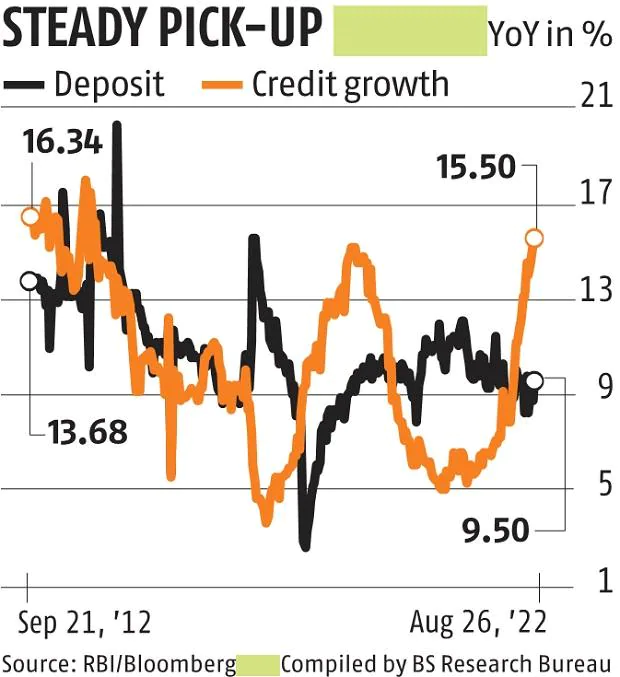Bank credit growth hits near nine-year high of 15.5%, shows RBI data
Credit growth of commercial banks is at a near nine-year high of 15.5 per cent year-on-year for the week ended August 26, latest data released by the Reserve Bank of India showed. The credit growth is the highest since November 1, 2013, when it was 16.1 per cent.
In the current financial year so far, banks have extended Rs 5.66 trillion by way of loans, representing a growth of 4.8 per cent as compared to -0.5 per cent during the same period last year.
“Credit growth in the system is quite robust currently and at a multi-year high but touching 20 per cent growth looks challenging given that most of the heavy lifting is being done by the retail segment,” Prakash Agarwal, director and head–financial institutions, India Ratings.
“For credit growth to touch 20 per cent, the pace of economic growth to be much higher entailed larger credit expansion on the industrial side as well as supporting deposit accretion. Credit growth should sustain at these levels for some time, especially with the festive season around,” he said, adding there could be some impact on loan demand going forward due to inflation and interest rate hikes.
Deposit growth was 9.5 per cent YoY, according to the data. Deposit growth has been trailing credit growth in this financial year, exacerbating concerns among analysts that slow deposit growth could emerge as one of the biggest constraints for loan growth in the system.
“We have seen a steady and broad-based pick-up in system credit growth despite rising interest rates, which we view positively. However, a widening gap between deposit and credit growth, remains our primary concern as it could lead to supply-side constraints going ahead,” said Macquarie Research in a report.

Credit growth has remained over 15 per cent for two consecutive fortnights now, indicating a more sustained pick up in demand. For the fortnight ended August 12, banking credit grew at 15.3 per cent and deposits grew at 8.84 per cent. The incremental credit-deposit ratio is at 107.13 per cent as of August 26.
“The concerning issue here is the widening credit – deposit growth gap which is multi year high. Banks need to plan as this may turn out to be a constraining factor. They would have to raise their deposit rates further to attract more deposits, which may lead to a rise in the MCLR in the system,” Agarwal said.
RBI’s latest sectoral deployment of credit for July 2022 pointed out that not only is the retail segment seeing handsome growth of almost 19 per cent, supported by both secured and unsecured loans, credit to industry also saw the highest growth since 2014, due to increased demand for working capital in an inflationary environment. Also, Indian corporates have now turned towards banks for their funding requirements given bond yields have moved up sharply as compared to lending rates of banks.
Among industries, loans to micro and small industries grew by 28.3 per cent YoY; medium industries saw 36.8 YoY growth; and large industries saw 5.2 per cent growth. According to a report by ICICI Securities, sectoral lending to petroleum, iron and steel, petrochemicals, and mining were the key drivers of industry credit growth. On the other hand, telecommunications, textiles, food, processing, and other infrastructure offset the accretion partially.
Credit growth has seen sustained rise since April this year, despite the RBI adopting a tighter monetary policy stance. RBI’s six-member monetary policy committee has increased the benchmark repo rates by 140 basis points since May this year and consequently the bank’s have also increased their external benchmark linked loans by the same proportion. However, the MCLR hike has not been to that extent which is drawing the industries to borrow more from the banking sector.
According to RBI data, about 43.6 per cent loans of the banking system are linked to the external benchmark, which could be the repo rate, or yields on government securities such as 91-day and 182-day Treasury Bills. And, about 49.2 per cent of the banking system loans are linked to the MCLR.
 Loan, Personal Loan, Home Loan, Business Loan,Loans in India Loan in India, Personal Loan, Home Loan, Business Loan, Loans in India,Loan Finance,Loan in India, Get Instant Personal Loan,Home Loan, Business Loans in India
Loan, Personal Loan, Home Loan, Business Loan,Loans in India Loan in India, Personal Loan, Home Loan, Business Loan, Loans in India,Loan Finance,Loan in India, Get Instant Personal Loan,Home Loan, Business Loans in India